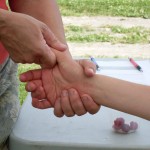 Muscle Energy Technique – this is a soft tissue treatment that requires active participation from the client. (In my experience, active participation from the client frequently helps the client get better faster, and more thoroughly, than passive participation.) Much research shows that using anywhere from 20-80% of the client’s force (in an isometric contraction against resistance) is effective (Farquharson, 2010 and Moore, Laudner, McLoda & Shaffer, 2011 are two examples). In my education, I was taught that using the gentlest pressure possible (<20%) achieves similar, if not greater, results.
Muscle Energy Technique – this is a soft tissue treatment that requires active participation from the client. (In my experience, active participation from the client frequently helps the client get better faster, and more thoroughly, than passive participation.) Much research shows that using anywhere from 20-80% of the client’s force (in an isometric contraction against resistance) is effective (Farquharson, 2010 and Moore, Laudner, McLoda & Shaffer, 2011 are two examples). In my education, I was taught that using the gentlest pressure possible (<20%) achieves similar, if not greater, results.
Positional Release – there are times when asking for client participation … just doesn’t make sense. During these times, I will pay attention to the ‘barriers’ that the body is exhibiting. Every inch of skin should be able to move equally in every direction. When it doesn’t, it is usually a sign that there is a dysfunction, of some sort, in that area of the body. In order to address the fascial, or soft tissue, dysfunctions, I will put that area in a position of ease, which is frequently its most shortened position. More often than not, this allows that part of the body to release its dysfunction, or at least to release that particular barrier.
Cranial Mobilization – This may or may not require participation. I use different amounts of pressure against different parts of the client’s cranium (and face), in order to induce relaxation of the muscles, and fascia, which attach the cranium (and face) to itself and to the spine. The muscles of the eye attach deep within the cranium, so incorporating eye movements into treatment of the cranium has been helpful.
Visceral Mobilization – This may or may not require client participation. I use different amounts of pressure on different areas of the viscera, or the abdomen and its contents. This frequently helps to release tension and adhesions within the abdominal cavity. The psoas muscle lies deep to the visceral organs and belly muscles, so incorporating hip flexion and extension into treatment of the viscera has been helpful.
Active Isolated Stretching – a concept taught by Aaron Mattes. This type of stretching should be done when you are NOT totally exhausted from your event. It requires the client to contract the antagonist, or the opposing muscle of the one you want to ‘stretch.’ This form of stretching has a goal in mind, which is to increase flexibility of that joint, via stretching. If that is not the goal, or result, of YOUR stretching program, you are wasting your time and you need to call me!
———————————–
- Farquharson, C. (2010). MET versus PNF; What, when and how? sportEX dynamics, 25(July), 12–16.
- Moore, S. D., Laudner, K. G., McLoda, T. A, & Shaffer, M. a. (2011). The immediate effects of muscle energy technique on posterior shoulder tightness. The Journal of Orthopaedic and Sports Physical Therapy, 41(6), 400–7. doi:10.2519/jospt.2011.3292
